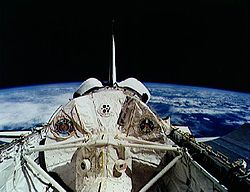
STS-55
Encyclopedia
Backup crew
Mission parameters
- MassMassMass can be defined as a quantitive measure of the resistance an object has to change in its velocity.In physics, mass commonly refers to any of the following three properties of matter, which have been shown experimentally to be equivalent:...
:- Orbiter landing with payload: 103191 kilograms (227,497.2 lb)
- Payload: 11539 kilograms (25,439.1 lb)
- PerigeePerigeePerigee is the point at which an object makes its closest approach to the Earth.. Often the term is used in a broader sense to define the point in an orbit where the orbiting body is closest to the body it orbits. The opposite is the apogee, the farthest or highest point.The Greek prefix "peri"...
: 304 kilometres (188.9 mi) - Apogee: 312 kilometres (193.9 mi)
- InclinationInclinationInclination in general is the angle between a reference plane and another plane or axis of direction.-Orbits:The inclination is one of the six orbital parameters describing the shape and orientation of a celestial orbit...
: 28.5° - PeriodOrbital periodThe orbital period is the time taken for a given object to make one complete orbit about another object.When mentioned without further qualification in astronomy this refers to the sidereal period of an astronomical object, which is calculated with respect to the stars.There are several kinds of...
: 90.7 min
Mission highlights
Columbia carried to orbit the second reusable German SpacelabSpacelab
Spacelab was a reusable laboratory used on certain spaceflights flown by the Space Shuttle. The laboratory consisted of multiple components, including a pressurized module, an unpressurized carrier and other related hardware housed in the Shuttle's cargo bay...
on the STS-55 mission and demonstrated the shuttle's ability for international cooperation, exploration, and scientific research in space. The Spacelab Module and an exterior experiment support structure contained in Columbia’s payload bay comprised the Spacelab D-2 payload. (The first German Spacelab flight, D-1, flew Shuttle mission 61-A
STS-61-A
STS-61-A was the 22nd mission of NASA's Space Shuttle program. It was a scientific Spacelab mission, funded and directed by West Germany – hence the non-NASA designation of D-1 . STS-61-A was the last successful mission of the Space Shuttle Challenger, which was destroyed during STS-51-L in 1986...
in October 1985.) The U.S. and Germany gained valuable experience for future space station operations.
The D-2 mission, as it was commonly called, augmented the German microgravity research program started by the D-1 mission. The German Aerospace Research Establishment (DLR) had been tasked by the German Space Agency (DARA) to conduct the second mission. DLR, NASA, the European Space Agency (ESA), and agencies in France and Japan contributed to D-2's scientific program. Eleven nations participated in the experiments. Of the 88 experiments conducted on the D-2 mission, four were sponsored by NASA.

The D-2 Mission conducted 88 experiments to study life sciences, material sciences, technology applications, Earth observations, astronomy, and atmospheric physics. It surpassed the 365th day in space for the Space Shuttle fleet and the 100th day of flight time in space for Columbia, the fleet's oldest Orbiter
Orbiter
An orbiter is a space probe that orbits a planet.-Asteroids:*NEAR Shoemaker...
on its fourteenth flight.
D-2 marked the first tele-robotic capture of a free floating object by flight controllers in Germany. The crew conducted the first intervenus saline solution injection in space as part of an experiment to study the human body's response to direct fluid replacement as a countermeasure for amounts lost during space flight. They also successfully completed an in-flight maintenance procedure for collection of orbiter waste water, which allowed the mission to continue.
STS-55 crewmembers participated in two amateur radio experiments, SAREX II from the United States and the German SAFEX. These experiments allowed students and amateur radio operators from around the world to talk directly with the Space Shuttle in orbit and participated in a SpaceMedicine conference with the Mayo Clinic.
Launch
Columbia was initially scheduled to launch in late February however this date slipped to early March due to concerns with the tip-seal retainers in the main engines' oxidizer turbopumps. All three turbopumps were replaced at the pad but later inspection revealed the retainers to be in good condition.Further delays were caused by the burst of a hydraulic flex hose in the aft compartment during the Flight Readiness Test. The lines were removed and inspected and three replacements were installed.
The launch attempt on 22 March was aborted automatically at T-3 seconds when computers detected an incomplete ignition of the number three Space Shuttle Main Engine
Space Shuttle main engine
The RS-25, otherwise known as the Space Shuttle Main Engine , is a reusable liquid-fuel rocket engine built by Pratt & Whitney Rocketdyne for the Space Shuttle, running on liquid hydrogen and oxygen. Each Space Shuttle was propelled by three SSMEs mated to one powerhead...
. The problem was traced to a leak in the liquid oxygen preburner check valve. All three SSMEs were replaced as a precaution.
Another launch attempt on 24 April was scrubbed due to a possible faulty reading with one of the inertial measurement units.
The final launch attempt was successful with liftoff at 10:50 am EDT on 26 April 1993.
See also
- Space scienceSpace scienceThe term space science may mean:* The study of issues specifically related to space travel and space exploration, including space medicine.* Science performed in outer space ....
- Space shuttleSpace ShuttleThe Space Shuttle was a manned orbital rocket and spacecraft system operated by NASA on 135 missions from 1981 to 2011. The system combined rocket launch, orbital spacecraft, and re-entry spaceplane with modular add-ons...
- List of space shuttle missions
- List of human spaceflights chronologically
- Space Shuttle abort modesSpace Shuttle abort modesA Space Shuttle abort was an emergency procedure due to equipment failure on NASA's Space Shuttle, most commonly during ascent. A main engine failure is a typical abort scenario. There are fewer abort options during reentry and descent...

